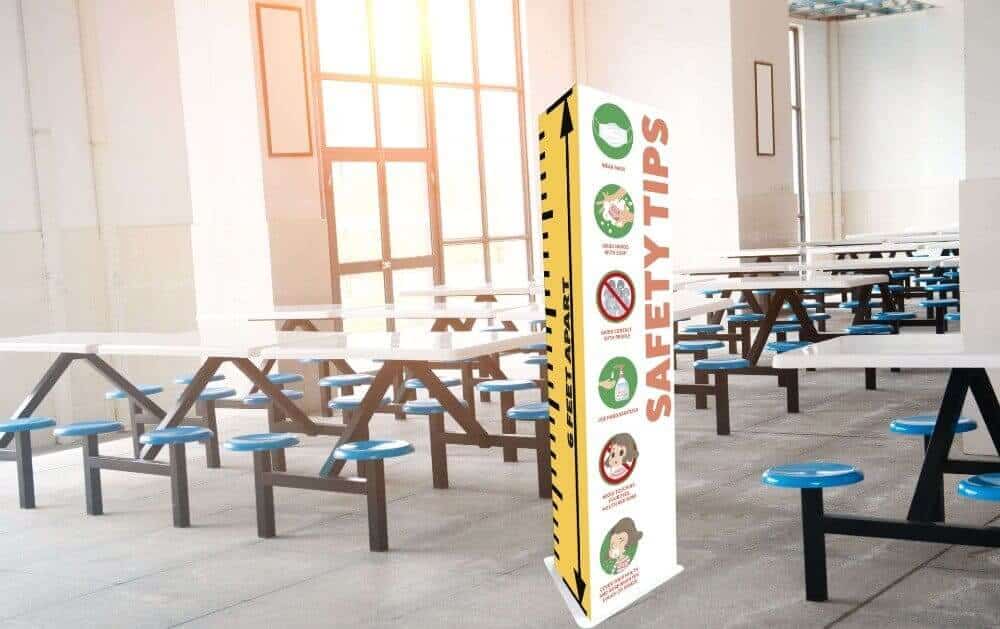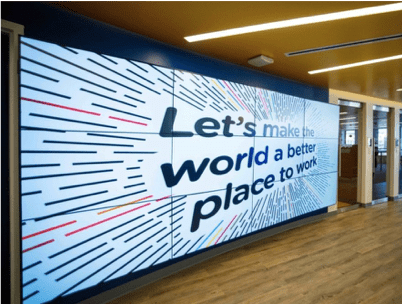From trade shows and take-out menus to sporting events and stockholder meetings, creative video wall applications can make a bold statement about your brand, school spirit or organization’s message.
The way businesses and organizations use LED displays is constantly growing. Where digital signage and video walls were once cost-prohibitive and accessible only to those with sizable budgets, advancements in technology have made them more affordable and accessible for businesses of any size. This increased availability and ease of use opens the door to a broad range of creative communications and marketing opportunities.
Creativity doesn’t have to be limited to a single screen. LED video walls offer a versatile canvas that goes beyond typical aspect ratios, allowing your creativity to shine. Whether you’re considering a multi-screen TV setup or exploring the flexibility of an LED wall, these solutions can be tailored to fit your organization’s unique needs.
But how do you choose the best option for your space? Keep reading — this guide will walk you through the key considerations and options to help you design the perfect video wall setup.
What is a Multi-TV Screen Wall?
As the name suggests, a multi-TV screen wall uses multiple screens configured to work together to display dynamic content.
What is a Video Wall?
A video wall is a large-format display composed of multiple screens or LED panels working together as a single cohesive display. While it can show a single feed of visual content, it also has the flexibility to display multiple feeds simultaneously, offering dynamic and versatile visual experiences.
Video Wall vs. Multi-TV Screen Wall
- Color Uniformity: LED panels deliver consistent color accuracy and brightness across the entire display, providing a seamless and vibrant viewing experience. Traditional screens may show variations in color and brightness, particularly across multiple units.
- Off-Axis Viewing: LED panels offer superior viewing angles, maintaining image clarity and color integrity even from wide angles, whereas traditional screens can lose image quality when viewed off-center.
- Seamless Design: LED panels can be constructed with minimal or no bezels, creating a truly seamless visual experience. Traditional screens often have noticeable bezels that can disrupt the overall aesthetic.
- Brightness Levels: LED panels typically offer higher brightness, making them ideal for environments with high ambient light, such as outdoor or brightly lit indoor spaces.
- Durability: LED panels are designed for long-term use and are more resistant to wear and tear, making them a reliable option for continuous operation. Chip-on-Board (COB) technology enhances durability even further by protecting the LED chips with a resin coating, improving resistance to physical damage and dust. Learn more about COB technology in this article.
- Flexibility in Shapes and Sizes: LED panels allow for greater flexibility in creating custom shapes and configurations, while traditional screens are constrained to standard dimensions and aspect ratios.
- Maintenance and Longevity: LED panels generally have a longer lifespan and are easier to maintain due to their modular design, whereas traditional screens may require full-unit replacements in case of damage.
These factors make LED panels a popular choice for modern video walls, especially in applications where visual impact and flexibility are paramount. With the cost of LED walls having come down so significantly, the price difference between an LED wall and a multi-screen setup is now negligible. Consulting with an AV advisor can help you determine the best solution for your space and ensure you maximize both your budget and your creative vision.
How to Combine TV Screens to Create a Video Wall
Creating a video wall using multiple TV screens can be a viable option for some applications, provided the setup is carefully planned and executed. While the results may not rival the seamlessness of a professional LED wall, the following steps will help you achieve a visually cohesive and functional multi-screen TV video wall:
1. Select the Right TVs
Choosing the right TVs is crucial for achieving a clean and cohesive display. Focus on the following specifications:
- Bezel Width: Opt for TVs with ultra-thin bezels to minimize visible gaps between screens.
- Resolution: Ensure the TVs offer high resolution to maintain clarity when combined into a larger display.
- Size and Consistency: Use TVs of the same model and size to ensure uniformity in brightness, color, and performance.
2. Plan Your Layout and Mounting Strategy
Decide on the layout of your video wall based on the space and content needs. Common configurations include 2×2, 3×3, or custom arrangements.
- Use sturdy, adjustable mounting hardware to securely position the TVs and allow for precise alignment.
- Ensure all screens are leveled and spaced consistently to create a unified display.
3. Configure Hardware and Software with a Video Wall Processor
A video wall processor is the key to achieving a cohesive, high-quality display. This device splits and syncs input signals across all screens while ensuring proper alignment and calibration:
- Alignment: The processor helps map content accurately across the TVs, reducing gaps and misalignments.
- Calibration: Use the processor to adjust brightness, contrast, and color settings for uniformity across all screens.
- Seamless Integration: Working with a professional AV integrator to install and configure the processor ensures optimal results. Professionals can fine-tune the setup, address any hardware issues, and enhance the overall performance of your video wall.
When setting up a 4 TV video wall, precision is key to achieving a seamless display. Here are some concise tips to guide you:
- Alignment: Ensure all four TVs are perfectly aligned using adjustable mounts to minimize gaps.
- Connections: Securely connect each TV to a reliable video wall processor for synchronized content display.
- Calibration: Uniformly adjust brightness, contrast, and color settings across all TVs for a cohesive visual experience.
- Professional Assistance: If challenges arise, consulting an AV integrator can enhance the setup’s quality and performance.
Implementing these steps will help you create an effective 4 TV video wall that meets your visual communication needs.
How to Set Up a Multi-Screen Video Wall
Setting up a multi-screen video wall can significantly enhance your visual displays, providing a dynamic platform for engaging content presentation
- Selecting Uniform Displays: Choose screens of the same size and resolution for a cohesive appearance.
- Planning the Layout: Determine the optimal arrangement (e.g., 2×2, 3×3) based on your space and objectives.
- Mounting the Screens: Securely install the displays using appropriate mounts, ensuring precise alignment.
- Integrating a Video Wall Processor: Use a processor to synchronize content across all screens.
- Calibrating Settings: Adjust brightness, contrast, and color for visual consistency.
For optimal results, consulting with a professional AV integrator is recommended.
The Benefits of a Video Wall
A video wall, whether utilizing multiple TVs or LED panels, offers several key benefits:
- Enhanced Visual Impact: Large, seamless displays command attention, making them ideal for high-visibility environments like command centers, conference rooms, and retail spaces.
- Flexibility and Scalability: Video walls can be customized in size and configuration to meet evolving needs, from simple multi-TV setups to expansive LED arrays.
- Immersive Viewing Experience: High-resolution displays create cohesive and engaging visuals, perfect for presentations, digital signage, or immersive environments.
- Branding and Messaging: Video walls provide an excellent opportunity to reinforce branding efforts, showcasing brand identity, values, and products prominently. With real-time content control, businesses can quickly update messaging to reflect current promotions, events, or information, ensuring relevance and engagement.
- Increased Visibility: The large, high-resolution displays of video walls capture attention, making them ideal for advertising and information dissemination in various settings.
By leveraging these advantages, video walls can effectively enhance brand visibility and communication strategies.
Video Wall Example
Multi-TV Wall Example





